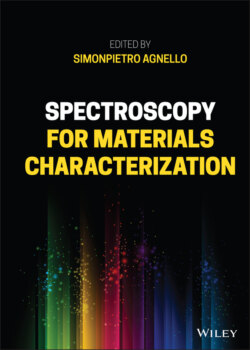Читать книгу Spectroscopy for Materials Characterization - Группа авторов - Страница 52
3.2 Ultrafast Optical Pulses 3.2.1 General Properties
ОглавлениеAn ultrafast optical pulse is an electromagnetic pulse characterized by a very short duration (from few femtoseconds to few hundreds of femtoseconds) and a broad spectral distribution (10–100 nm FWHM) in the near‐infrared, visible, or UV spectral range. Generating ultrafast pulses relies on the use of a mode‐locked laser, which exploits the amplification of a large number of laser modes oscillating in‐phase within the laser cavity [19, 20]. The most widespread type of femtosecond mode‐locked laser in modern spectroscopy is the Ti:sapphire laser. A typical Ti:sapphire oscillator emits laser pulses with a central wavelength tunable around 800 nm, typical duration of 10–100 fs, energy of 1–100 nJ pulse−1, and repetition rate of ∼80 MHz. By using an external amplifier, these pulses can be then amplified up to μJ or mJ per pulse with a proportional reduction of the repetition rate. Because of the very short duration, these numbers imply intensities as high as tens of GW per cm2, which can easily be achieved even without focusing. These intense, amplified pulses are then available to feed a range of experiments in nonlinear optics and spectroscopy such as those described in this chapter. The details of mode‐locking will not be further discussed here, and the rest of this section will be devoted to describing some general properties of propagating femtosecond light pulses.
The time dependence of the oscillating electric field in an amplified ultrashort pulse is described by . The wave amplitude follows a Gaussian envelope, with the shape factor γ proportional to the squared inverse of the duration of the pulse: γ ∝ Δt −2. To obtain the spectral content of the pulse, one can calculate the Fourier transform of E(t), which is shown to be again a Gaussian function, centered at the frequency ω 0 and with a frequency width Δω proportional to γ 1/2 [19]. This entails a strict relation between the time duration of the pulse and its spectral width, according to Heisenberg's uncertainty principle . This leads to the fundamental consequence that ultrashort laser pulses are intrinsically non‐monochromatic: in order to have pulse durations in the femtosecond range, it is compulsory to have a broad enough spectral distribution, typically in the tens of nanometers. When the equivalence of the uncertainty principle is verified, the pulse is named Fourier transform‐limited. This condition can only be perfectly achieved by a Gaussian pulse, and guarantees the shortest possible pulse for a given spectral width. For example, a transform‐limited Gaussian pulse with 10 fs duration, peaking at 800 nm, shows a spectral bandwidth of 94 nm. As discussed hereafter, one consequence of the broad bandwidth of femtosecond pulses is that their propagation is affected by strong dispersion effects [19, 20]. On the other hand, their extremely high peak intensities, due to the short duration, lead to intense nonlinear optical effects.
